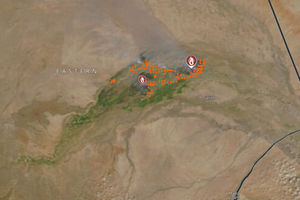Private jet emissions surge 46 per cent in five years, study reveals

An image of a private jet. PHOTO/Shutterstock
What you need to know:
- Private jets have become a symbol of luxury and status
- Scientists have found that carbon emissions from private flights surged by 46 per cent between 2019 and 2023.
- At least 15.6 million tonnes of carbon dioxide were produced by private jets in 2023, as the research indicates.
Private jets have become a symbol of luxury and status, gaining popularity among world leaders, including those in less developed African nations like Kenya.
In May last year, President Ruto sparked controversy by chartering a Boeing 737-700 business jet for his trip to the United States, a decision that cost taxpayers Sh98 million one way. He defended the choice, arguing it was more cost-effective than flying commercially. However, as private jet use continues to rise, a new study reveals that their carbon emissions have increased by nearly 50 per cent over the past five years, highlighting the environmental cost of this growing trend.
Scientists have found that carbon emissions from private flights surged by 46 per cent between 2019 and 2023.
While private jets are owned by merely a fraction of the world's population (0.003 per cent), their contribution to climate change is monumental, according to a team of scientists at Sweden's Linnaeus University.
At least 15.6 million tonnes of carbon dioxide were produced by private jets in 2023, as the research indicates.
This was equivalent to nearly 1.8 per cent of the total emissions from commercial aeroplanes in 2023 and an increase of 46 per cent in carbon dioxide produced by private jets in 2019.
Interestingly, the United Nations Framework Convention on Climate Change (UNFCCC) 28th Conference of the Parties (COP 28) is among the international events that recorded large volumes of private jets and massive amounts of carbon emissions.
The global climate conference, which took place in Dubai, United Arab Emirates (UAE) between November 30 and December 13, 2023, and the FIFA World Cup held in 2022 are the top international events in which levels of carbon emissions peaked.
According to the analysis published in the Communications Earth & Environment journal, 4,800 tonnes of carbon dioxide were released from 644 private aircraft used to attend COP 28.
The 2022 FIFA World Cup accounted for 14,700 tonnes of carbon dioxide emissions produced by 1,846 private jets.
"Individuals with the highest emissions released 2,400 tonnes of carbon dioxide per person in 2023, according to the unique tail numbers of their private aeroplanes," the report read in part.
The lead researcher, Stefan Gössling, explained, "This was approximately 500 times more than the levels of carbon emissions released by each individual in 2020, equivalent to 4.5 tonnes of carbon dioxide."
Apart from the carbon cost of a private jet lifestyle, the findings revealed that private aircraft are mostly used in summer and on weekends indicating that they are mainly for leisure.
Further, the experts noted that the majority of those luxurious trips made by high-net-worth individuals (HNWIs) could have easily been made by other means of transportation such as motor vehicles. The researchers analysed 18,655,789 flight data from 25,993 registered business private aircraft between 2019 – 2023.
To calculate the amount of carbon from each aircraft, they combined the flight trajectory and duration with the advertised fuel consumption rate of the aircraft.
The researchers say that the study highlights the significant role played by private flights in carbon emissions and climate change. Only a few individuals account for the massive carbon footprint produced in 2023 but experts have cautioned that without stringent regulations to check the ultra-luxury industry, the harmful emissions will continue to surge.
Private aircraft are highly energy intensive and they release large volumes of carbon dioxide from each passenger compared to commercial flights.
Experts have raised concerns over what they term a "poor understanding" of the actual scale of private flights worldwide and the amount of carbon emissions it releases.
"Even though private jets release small amounts of carbon dioxide compared to the overall emissions globally, it is paramount that there is more scrutiny on the ultra-high-wealth individuals."
Professor Gossling opines" If individuals who emit the highest volumes are not forced to pay the cost of their carbon emissions, how can we ask any other person?"
The recent study comes even as the market size of private aircraft is projected to bulge to Sh7.3 trillion by 2033 from Sh3.5 trillion in 2023 with a 7.6 per cent Compound Annual Growth Rate (CAGR) between 2024 – 2033.
Private aircraft comprise a variety of aeroplanes ranging from luxurious business jets to single-engine aircraft, that are owned by corporations or individuals for personal or business use, as defined by the Global Private Aircraft Market Report 2023 – 2033.
Their ability to offer assorted benefits, particularly flexibility and privacy has made them popular among elites who prefer them to commercial aviation.
Global economy expansion, which has enhanced leisure travel and international business trips, has significantly increased private flights even as statistics indicate growing popularity and demand for private jets.
SIDEBAR:
Key Research Findings:
- Private jets, used by just 0.003% of the world's population, produced 15.6 million tonnes of CO2 in 2023
- This represents approximately 1.8% of all commercial aviation emissions.
- Individual high emitters released about 2,400 tonnes of CO2 per person in 2023 - roughly 500 times more than the average person's 4.5 tonnes in 2020
Particularly notable was the environmental impact of high-profile events:
- COP28 climate conference in Dubai: 644 private aircraft generated 4,800 tonnes of carbon dioxide
- 2022 FIFA World Cup: 1,846 private jets produced 14,700 tonnes of carbon dioxide
The researchers emphasise the need for:
- Greater scrutiny of ultra-high-wealth individuals' carbon footprints
- Stricter regulations on the ultra-luxury aviation industry
- Better understanding and tracking of private flight emissions globally
- Implementation of carbon pricing mechanisms for private aviation





